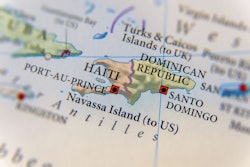
Laying hens may benefit from the inclusion of more coarse limestone in their diets, research concludes.
Adding more coarse limestone to laying hen diets may produce eggs with stronger shells, according to research from Mississippi State University.
Hens fed 15% fine limestone and 85% coarse limestone laid stronger eggs regardless of a variety of other factors, according to the study, which was funded by the U.S. Poultry & Egg Harold E. Ford Foundation. Industry guidance recommends a lower inclusion of coarse limestone at 40% fine and 60% coarse particles, according to Pratima Adhikari, an assistant professor at Mississippi State University.
Scientists at the university had reason to believe that including more coarse limestone in the diet might improve the eggshell quality, Adhikari said. In an exploratory experiment at the university two years ago, hens were fed varying combinations of fine and coarse limestone in order to gather data on the effect of different blends. The thought was that older laying hens may benefit from more fine limestone. However, the researchers noted that, at the 15:85 ratio, the hens seemed to produce stronger eggshells.
The research team aimed to compare this ratio against the industry standard in hens under and over 60 weeks of age in their more recent work. Once again, they found the coarser limestone blend improved eggshell quality in hens under 60 weeks of age, although it appeared to decrease total egg production over 60 weeks.
Experiments with different levels of phytase, which the researchers thought would further aid bone and eggshell development, generated mixed results. While higher levels of phytase resulted in signs of improved gut health, Adhikari said, the enzyme’s impact on eggshell quality was inconsistent.
Phytase inclusion at the standard 400 phytase units together with coarse limestone particle size improved the freshness and quality of eggs. At 1,500 phytase units together with coarse limestone, the enzyme seemed to improve the egg-breaking strength but reduced overall egg production resulting in more unsellable eggs, Adhikari said. The positive effects of the coarser limestone remained consistent regardless of whether or how much phytase was included in the diet.
“Therefore, somewhere lower than 85% coarse limestone and 1500 FTU phytase can be recommended but we need to do more research,” Adhikari said.
Adhikari said she would recommend producers consider offering more coarse limestone to younger laying hens, but said more work is needed to determine whether phytase inclusion rates should be altered.
The study results “tell us that something more than phytase level is directly impacting the eggshell, that there might be something going on with the birds’ physiology that we don’t have an answer to yet,” Adhikari said.















